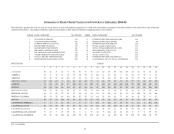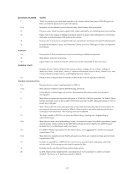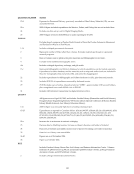99
a publication in any medium issued in successive parts bearing numerical or
chronological designations and intended to be continued indefinitely. This
definition includes periodicals, newspapers, and annuals (reports, yearbooks,
etc.) the journals, memoirs, proceedings, transactions, etc. of societies and
numbered monographic series.
In the case of consortial agreements, count under Q4a only those subscriptions to titles for which the library pays
directly from its budgeted expenditures reported under Q15b (expenditures for serials). Count under Q4a only those
titles and subscriptions for which your library pays. Report other subscriptions that your library receives and does
not pay for directly under Q4b (serials received and not purchased). If a purchased subscription includes electronic
access to the title, count that subscription twice: once for the print version and once for the electronic version. If
serials have been purchased through a consortium whose budget is centrally funded and independent from the
library's budget, these serials should be reported under Q4b.
Do not include the full-text serials from such indexing/abstracting products as Wilson Social Sciences Abstracts
Full Text, Lexis-Nexis, ABI/INFORM, and other indexes with access to the full text of articles. These full-text titles
are counted in in the ARL Supplementary Statistics.
Question 4b. Serials: Not Purchased. Record those serials whose subscriptions were received without purchase
for whatever reason. If separate counts of nonpurchased and purchased serials are not available, report only the total
number of current serials received on line 4, and report U/A for lines 4a and 4b.
Question 6. Microforms. Report the total number of physical units: reels of microfilm, microcards, and
microprint and microfiche sheets. Include all government documents in microform provide a footnote if documents
are excluded.
Question 7. Government documents. Report the total number of physical units (pieces) of government
documents in paper format that have not been counted elsewhere. Include local, state, national, and international
documents include documents purchased from a commercial source if shelved with separate documents collections
and not counted above. Include serials and monographs. To estimate pieces from a measurement of linear feet, use
the formula 1 foot =52 pieces and indicate in a footnote that the count is based on this estimate. Exclude
microforms and nonprint formats such as maps or CD-ROMs. Adjust line 1a, i.e., last year’s Volumes Held, and
provide a footnote if you are adding records to the OPAC for government documents previously held but not
counted as part of Volumes Held (line 1a).
Question 8. Computer files. Include the number of pieces of computer-readable disks, tapes, CD-ROMs, and
similar machine-readable files comprising data or programs that are locally held as part of the library’s collections
available to library clients. Examples are U.S. Census data tapes, sample research software, locally-mounted
databases, and reference tools on CD-ROM, tape or disk. Exclude bibliographic records used to manage the
collection (i.e., the library’s own catalog in machine-readable form), library system software, and microcomputer
software used only by the library staff.
Question 9. Manuscripts and archives. Include both manuscripts and archives measured in linear feet.
Question 10. Cartographic materials. Include the numbers of pieces of two- and three-dimensional maps and
globes. Include satellite and aerial photographs and images.
Question 11. Graphic materials. Include the number of pieces of prints, pictures, photographs, postcards, slides,
transparencies, film strips, and the like.
Question 12. Audio materials. Include the number of pieces of audiocassettes, phonodiscs, audio compact discs,
reel-to-reel tapes, and other sound recordings.
Question 13. Film and video materials. Include the number of pieces of motion pictures, videocassettes, video
laser discs, and similar visual materials.
a publication in any medium issued in successive parts bearing numerical or
chronological designations and intended to be continued indefinitely. This
definition includes periodicals, newspapers, and annuals (reports, yearbooks,
etc.) the journals, memoirs, proceedings, transactions, etc. of societies and
numbered monographic series.
In the case of consortial agreements, count under Q4a only those subscriptions to titles for which the library pays
directly from its budgeted expenditures reported under Q15b (expenditures for serials). Count under Q4a only those
titles and subscriptions for which your library pays. Report other subscriptions that your library receives and does
not pay for directly under Q4b (serials received and not purchased). If a purchased subscription includes electronic
access to the title, count that subscription twice: once for the print version and once for the electronic version. If
serials have been purchased through a consortium whose budget is centrally funded and independent from the
library's budget, these serials should be reported under Q4b.
Do not include the full-text serials from such indexing/abstracting products as Wilson Social Sciences Abstracts
Full Text, Lexis-Nexis, ABI/INFORM, and other indexes with access to the full text of articles. These full-text titles
are counted in in the ARL Supplementary Statistics.
Question 4b. Serials: Not Purchased. Record those serials whose subscriptions were received without purchase
for whatever reason. If separate counts of nonpurchased and purchased serials are not available, report only the total
number of current serials received on line 4, and report U/A for lines 4a and 4b.
Question 6. Microforms. Report the total number of physical units: reels of microfilm, microcards, and
microprint and microfiche sheets. Include all government documents in microform provide a footnote if documents
are excluded.
Question 7. Government documents. Report the total number of physical units (pieces) of government
documents in paper format that have not been counted elsewhere. Include local, state, national, and international
documents include documents purchased from a commercial source if shelved with separate documents collections
and not counted above. Include serials and monographs. To estimate pieces from a measurement of linear feet, use
the formula 1 foot =52 pieces and indicate in a footnote that the count is based on this estimate. Exclude
microforms and nonprint formats such as maps or CD-ROMs. Adjust line 1a, i.e., last year’s Volumes Held, and
provide a footnote if you are adding records to the OPAC for government documents previously held but not
counted as part of Volumes Held (line 1a).
Question 8. Computer files. Include the number of pieces of computer-readable disks, tapes, CD-ROMs, and
similar machine-readable files comprising data or programs that are locally held as part of the library’s collections
available to library clients. Examples are U.S. Census data tapes, sample research software, locally-mounted
databases, and reference tools on CD-ROM, tape or disk. Exclude bibliographic records used to manage the
collection (i.e., the library’s own catalog in machine-readable form), library system software, and microcomputer
software used only by the library staff.
Question 9. Manuscripts and archives. Include both manuscripts and archives measured in linear feet.
Question 10. Cartographic materials. Include the numbers of pieces of two- and three-dimensional maps and
globes. Include satellite and aerial photographs and images.
Question 11. Graphic materials. Include the number of pieces of prints, pictures, photographs, postcards, slides,
transparencies, film strips, and the like.
Question 12. Audio materials. Include the number of pieces of audiocassettes, phonodiscs, audio compact discs,
reel-to-reel tapes, and other sound recordings.
Question 13. Film and video materials. Include the number of pieces of motion pictures, videocassettes, video
laser discs, and similar visual materials.


















































































































































